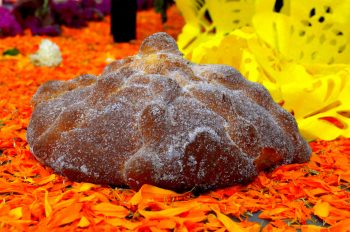Recipe: Day of the Dead Bread Posted by Karoly Molina on Nov 1, 2019 in Uncategorized
One of my favorite things about this time of the year is the availability of pan de muerto or Day of the Dead bread. In Mexico, people have their selected panaderias or bakeries where they regularly get their pan de muerto. Last year, a friend of mine invited me to her house to bake the bread together, and, while it was a lot of work, the breads we made turned out delicious. This year, I am making it again and in this post, I want to share with you the recipe, tips for making it and a few varieties.
Los ingredientes
Lets start with the ingredients or ingredientes for this delicious bread. You will need the following:
- 30g levadura (yeast)
- 1/4 tazas de agua tibia (warm water)
- 6 tazas de harina (cups of flour)
- 5 huevos (eggs)
- 1 lata de leche condensada (1 can of condensed milk)
- 5 yemas (yolks)
- 250g de mantequilla (butter)
- 2 cucharadas de agua de azahar (spoons of orange blossom water)
- 2 huevos para barnizar (eggs to glaze)
- 1-4 tazas de azúcar granulada para espolvorear (cups of granulated sugar to sprinkle)
A few notes on the ingredients:
- The water is only needed if the type of yeast you buy asks for it. The yeast I used just needs to be mixed with the flour so check this before.
- Normally, you would use regular flour, but you can substitute it for whole wheat or integral.
- Eggs for the recipe should be medium size
- In the Netherlands, we have baking butter and regular butter. I’ve used both and it comes out delicious either way.
- Orange blossom water can be found in the “international” isle of your local grocery store. I found a Turkish brand. You can also use orange blossom essence, but check for portion.
- You can substitute the orange blossom water for orange zest.
La receta
Now lets focus on the steps to make the pan de muerto. For the sake of clarity, I will write them in both languages.
- Disuelva la levadura en el agua tibia, agregue 1/2 taza de harina, forme una pastita y deje reposar 15 minutos.
(Dissolve the yeast in the warm water, add 1/2 cups of flour, create a paste and let it sit for 15 minutes.) - Cierna la harina restante sobre una mesa o tabla de amasar, y forme un hueco en el centro. Agregue los huevos, la leche condensada, las yemas, la mantequilla y el agua de azahar.
(Sift the remaining flour on a table or a kneading table/matt, and leave a hole in the center of the flour. Add the eggs, condensed milk, yolks, butter and orange blossom water. - Mezcle con las manos, añadiendo la masa de levadura que dejó en reposo.
(Mix with your hands adding the yeast mix that you previously let sit.) - Siga amasando hasta que se despegue de la mesa.
(Continue kneading until the dough lifts from the table.) - Vacíe en un molde ligeramente engrasado y deje reposar 2 horas aproximadamente, hasta que su tamaño sea el doble.
(Place the dough on a slightly greased bowl and let it sit for approximately 2 hours until it has doubled in size.) - Divida la masa en 4 partes y separe una pequeña porción de cada una para los adornos.
(Divide the dough in 4 parts and separate a small portion of each part for the decoration.) - Coloca las 4 porciones grandes en una charola para hornear con suficiente espacio entre cada una. Usa la porción pequeña de cada una para hacer los “huesitos” y “el craneo.”
(Place the four big portions on a baking sheet with ample room in between. Use the small portions to make the little bones and skull for decorations.) - Deja nuevamente reposar en un lugar tibio hasta que doble su volumen.
(Let it sit once again in a lukewarm place until it doubles it size.) - Precaliente el horno a 200° C/ 400° F.
(Preheat oven to 200° C/400° F.) - Barnice con huevo y espolvoree con azúcar.
(Glaze with the eggs and sprinkle with sugar.) - Hornee 30 minutos o hasta que dore ligeramente.
(Bake for 30 minutes or until it is slightly golden.)
Consejos
- You can certainly use your mixer instead of mixing everything on the table. Just make sure you add the ingredients slowly.
- Be patient and strong with your kneading. If your surface gets very sticky, keep on kneading until the bits slowly stick to the dough.
- Instead of making 4 smaller breads, you can choose to make two big ones. Once it is baked, cut like a cake.
Variedades
- You can opt for the more traditional bread that has no sprinkled sugar.
- In the state of Puebla, pan de muerto can be found sprinkled with ajonjolí or sesame seeds instead of sugar.
- You can substitute the orange blossom water for anise or anís.
- You can use colourful sugar. Traditionally, you would use red or pink which simbolizes blood.
- There are certainly vegan varieties. You can see one recipe in the video below.
Origen
If you want to know more about the origins of the pan de muerto, I invite you to check this video. I must warn you that the origin of this deliciously sweet tradition goes back to pre-colonisation and is quite bloody.
Do you celebrate Day of the Dead? Have you ever tried pan de muerto?

Build vocabulary, practice pronunciation, and more with Transparent Language Online. Available anytime, anywhere, on any device.




